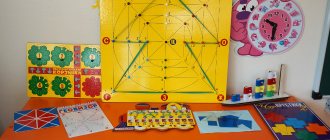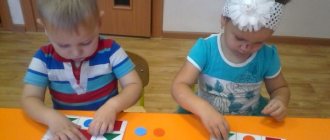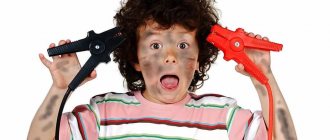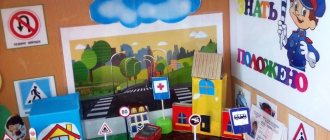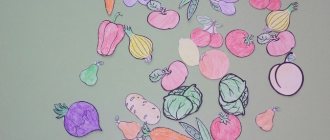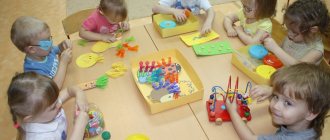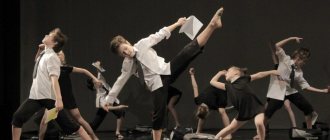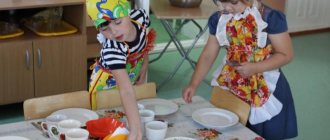How to make a square with your own hands
All you need to create an educational toy with your own hands is a piece of flexible, durable material and bright, durable triangles. The easiest and safest way to make this toy is to sew it from fabric.
It will be pleasant to the touch, flexible and at the same time very durable (much stronger if folded, for example, from paper). In order to make a more rigid version, you can take a piece of thick cardboard (or thin plastic) and flexible non-marking fabric for the base.
Having made the pattern, you just need to glue the triangles on both sides to the base. You can also watch a master class on making a square from other available materials.
What to do next
Games using the Voskobovich method allow the child to get acquainted with the world around him, but sooner or later the child will outgrow this wonderful toy. Then it makes sense to have other exciting toys using the Voskobovich method - by the way, they are also easy to make with your own hands, but if you wish, you can buy ready-made ones.
With the help of such games, you can improve your child’s logical and spatial thinking, teach him basic arithmetic skills, and introduce him to modeling and spatial geometry.
I also want to note that it is very important to develop the child evenly. You shouldn’t go into some narrow area; it’s best when the baby is in harmony
This means that from time to time he needs to learn abstract thinking.
By developing a child harmoniously, you can achieve great heights - his creative potential will grow, and his creative and intellectual abilities will increase and improve.
Did you like our content? Subscribe to the channel in .
“Master - class “Magic Square” for educators - presentation
© Fokina Lidiya Petrovna Completed by teacher Orekhova N.A.
MKDOU d/s 2 “Swallow”, Semiluki © Lidia Petrovna Fokina Goal: Improving the professional competence of teachers. Objectives: Expand the understanding of the game simulator Voskobovich square; To develop skills for practical use of it in classes and independent activities of children; Create an atmosphere of cooperation and co-creation among teachers.
© Lidia Petrovna Fokina “Tell me and I’ll forget, show me and I’ll remember, let me try and I’ll understand” Chinese wisdom says
© Fokina Lidiya Petrovna Voskobovich’s two-color square is a fabric base onto which plastic triangles are glued. They are green on one side and red on the other. Between the triangles there are strips of fabric along which the square can be bent.
© Fokina Lidia Petrovna the ability to distinguish geometric shapes, determine their properties and sizes, spatial thinking, imagination, logic, attention, ability to compare and analyze, flexibility of thinking, hand motor skills, creativity, sensory abilities, ability to design. Classes with the “Voskobovich Square” develop:
© Lidia Petrovna Fokina “Introduction to the “Voskobovich Square”
© Fokina Lidiya Petrovna -I invite you to go on a journey to a fairytale forest. Do you agree? - And the “magic square” will help us get ready for the trip.
© Fokina Lidiya Petrovna - Let's take some candy with us
© Fokina Lidiya Petrovna Put the candies in your purse
© Fokina Lidiya Petrovna Let's leave a note that we went on a trip and put it in an envelope.
© Fokina Lidiya Petrovna Shoe
© Fokina Lidiya Petrovna - We will go on a trip by boat, and then fly by plane.
© Fokina Lidia Petrovna
List of materials used: nals/e5/d8/e5d88329b88469dfc559cab72a5187c7.jpg?itok=2Hcne-Rehttps://cdn2.kidtrend.ru/sites/kidtrend.ru/files/styles/product_full/public/exter nals/e5/d8/e5d88329b884 69dfc559cab72a5187c7 .jpg?itok=2Hcne-Re - Voskobovich square jpg - folding diagram of the aircraft 45/154-voskobovich V. Voskobovich and his “Fairytale Labyrinths”. 45/154-voskobovich html Method of V. Voskobovich. "Fairytale labyrinths games." razvivayushchie-igry-novogo-pokoleniya.html#igrihttps://dohcolonoc.ru/doklady-pedsovety-v-dou/6551-seminar-praktikum- razvivayushchie-igry-novogo-pokoleniya.html#igri For the publication of information about children, a written request has been received permission of parents (legal representatives). The author of the photographs is N.A. Orekhova. The template is made from figures in PowerPoint template source: Lidiya Petrovna Fokina Website
Website of psychologist E.V. Pyatashova
A new item has appeared in my games file - the educational game “Transparent Square” by V.V. Voskobovich.
The game is aimed at developing creative and sensory abilities, as well as various mental processes: perception, attention, memory, thinking, and speech. Recommended age: 3-9 years.
This is what it looks like from the outside:
And here it is inside:
The game consists of transparent plates depicting various geometric shapes. Some occur once, others up to 9 times. Interestingly, the design is also visible on the reverse side, only in a mirror image.
First, the children of employees (schoolchildren) got acquainted with the game:
They submitted their ideas to the Transparent Idea 2018 competition
Currently, there is an active testing of the use of the manual in working with preschoolers with SLD.
Transparent square - multivariate constructor . And a whole card index (album of figures) allows you to use the game within the framework of each lexical topic (wild and domestic animals, wintering and migratory birds, etc.).
“Transparent Square” is not only a construction set.
In the correctional and developmental work of a teacher-psychologist, the following options for using the manual are possible:
Game "Find a Pair".
The goal is to choose a pair for the figure (development of visual perception, visual attention, sensory development (shape, size).
Age: from 3 years old.
Game "Fold the square"
The goal is to put together a square from identical or different parts (development of visual perception, visual attention, thinking (synthesis), formation of “part-whole” concepts).
Age: from 4 years old.
Game "Mirror"
The goal is to mirror the figure on the plate (development of visual perception, attention, thinking).
Age: from 5 years old.
Game "Fold 1"
The goal is to choose from the proposed options the one that results when connecting (end-to-end or overlapping) the images on the first two plates) (development of logical thinking). In the future, you can invite the child to choose the appropriate option from a variety of squares.
Age: from 5 years old.
Game "Fold the figure 2".
The goal is to choose from the proposed options the one that needs to be connected to the figure on plate 1 (end-to-end or overlapping) to get the figure on plate 3 (development of logical thinking). In the future, you can invite the child to choose the appropriate option from a variety of squares.
Age: from 5 years old.
Game "Find the extra piece."
The goal is to find a figure that differs from others in some way, to explain the choice (formation of mental operations (exclusion).
Age: from 4 years old.
A variant of the task for this game is to swap the plates.
A variant of the task for this game is to unfold the plates in space.
Game “Fold the image”
The goal is to put together any image from 2 or more plates according to the child’s intention (development of thinking, imaginative imagination).
Age: from 5 years old.
Game "What has changed?"
The goal is to find differences in the series from the original sample (development of visual perception, visual attention, visual memory).
Age: from 4 years old.
Initial sample
Change option (swap the plates)
Change option (we change the location in space)
Change option (who hid?)
Thus, this educational game can be used in individual and subgroup correctional and developmental work in preschool educational institutions, as well as work with gifted preschoolers (my project). It is interesting for children of all age groups of preschool educational institutions and is very effective in the development of all mental processes (especially thinking). I recommend!!!
Voskobovich's first games
The first benefits appeared in the early 90s. The game “Geokont”, “Game Square” (now it is Voskobovich Square), “Folds”, “Color Clock” immediately attracted attention. By that time, Vyacheslav Voskobovich’s gaming practice was not limited only to the family; for several years he led children’s groups in educational games and literacy training.
With games and experience, they began to invite me to seminars. From the beginning in his native Leningrad, then to other cities.
There were more and more games - “Transparent Square”, “Transparent Number”, “Dominoes”, “Multiplication Planet”, the “Miracle Puzzles” series, “Math Baskets”... The first methodological fairy tales appeared.
Educational games
Having such manuals, you can simulate different and endless options for playing with them.
Inventions are beginning to give more and more imagination to new ones, so we can get acquainted with such play sets as:
Geokont, a construction game, but unique. The nails are arranged on a wooden board in a certain order and colored rubber bands are included in the kit. At first glance, I personally found it uninteresting. But if we take a closer look, we find ourselves with the child in the fascinating world of geometry and travel with the heroes Uncle Slava, Mater the raven and others. We study colors and shapes, fantasize using the attached diagrams and invent our own.
Voskobovich square. Plastic triangles on a fabric basis in two or four colors. The set includes a book - instructions describing the magic figures that can be assembled using this square.
Folding boxes
- Methodical tales
- Sensory country "Purple Forest"
- Miracle puzzles: miracle - crosses, miracle - flowers, miracle - honeycombs
- Labyrinths of letters and numbers
- Teremki for teaching reading from 3 years (cubes with inserts)
- Insert Games
- Laces
- A boat for teaching numbers and counting “Bul-Bul” and “Splash-Splash”
- Cards with letters. A peculiar alphabet, somewhat similar to the alphabet of S. Lupan
Voskobovich has developed truly incredible creative gaming aids and educational games that perfectly develop the sensorimotor skills of a preschool child.
They reveal his creative potential, imagination, normalize his mental background, and all this by immersing the child in the fantastic world of fairy tales and adventures. Now his developments are successfully used in preschool and school institutions. They are also freely available for sale and can be easily practiced at home, which can keep your child occupied for a long time and free up precious time for mom.
A development center of the same name has been opened, Voskobovich Educational Games LLC, which is engaged in the production and development of manuals.
The essence of the technique
We learn by playing
In the game process, the child immediately receives several developmental moments at the same time: counting and reading, attention and imagination, logic and memory. This way we get comprehensive development. The author takes an interesting fairy tale as a basis.
So, in his opinion, the child will receive educational information in a fun and relaxed way. Each game has its own fairy tale, with its own heroes who need to be helped by completing certain tasks and exercises. A child and an adult, or later, the child himself, can play both according to the proposed scenario and develop his creative abilities and come up with new characters, new plots and new riddles.
A few notes
I think many people are interested in this toy, so I’ll share my own observations. Games using the Voskobovich method should be used with children starting from two years old. At first these will be the simplest manipulations - the baby will fiddle with a nice bright square, learn to fold it, but every year the game will become more complicated.
Gameplay allows children to do things on their own. This develops responsibility and also gives complete satisfaction from the learning process. At the age of 2-4 years, it is very important to consolidate the positive effect of learning, then in the future it will be much easier to get used to the teaching and educational process.
It is best to use educational games together with a teaching aid - there are illustrated fairy tales, various folding algorithms that will help diversify the process.
OOD progress:
(Children sit on chairs)
Educator: Look, today we have many guests - these are kindergarten employees. Let's wish everyone a good morning (children greet guests)
.
Now listen to me carefully, everyone.
Today I want to play a fairy tale with you. Do you remember why Baby Geo went on his journey? (children's answers)
Yesterday, for example on April 1, he sent an SMS message saying that he had gone to Lake Ice. There he found and completed all the tasks of the jester Dwan and will return to us on April 2. Can you guess when this will happen (children's answers)
That’s right, today, but I haven’t seen him yet, apparently he’s on his way.
Guys, he also reminded me that I need to help his friends write a letter.
Are you willing to help? (children's answers)
To do this we need to get to the Castle of Transformations! Shall we try? (children get up and approach the drawn castle)
.
Educator: Look, the gate to the Castle is locked. Let's try to open it (I suggest several different keys)
.
What's the matter? That's right, it's a combination lock. How can we open it? Code, what is code? (children's answers are a set of numbers that only the owner knows)
.
Wait, wait, I think I guessed it: a code card-badge with three identical numbers on it, which Baby Geo left for me when he went to Ice Lake. Look at it and name the code (children call 555, set the code and “open”
lock).
Educator: Great, now that we’re in the castle we can help Baby Geo’s friend. Now you will go to your rooms (to the tables, the table number corresponds to your badge number)
.
Physical minute: If you have fun, do this (clap in front of yourself)
If you have fun, do this (clap in front of yourself)
We boogie-boogie, turning in circles (turning around)
And we all do it together like this (clapping overhead)
If you have fun, do this (turn to the sides)
If you have fun, do this (turn to the sides)
We boogie-boogie, turning in circles (turning around)
And we all do it together like this (squats)
Next I tell a fairy tale, the children perform transformations of a square.
Educator: Little Geo left a portrait of a friend in each room. Take the portrait out of the envelope, get to know him, say his name (children's answer is Square)
.
And what can a square tell about itself (children’s answers: it is two-colored, it has four sides, all sides are equal, the angles are right, it can be folded diagonally, in half).
Well done, I see that you are ready to play a fairy tale with me, to become my assistants. Ready? (children's answers)
Educator: I remind you of the rules of the game: be attentive, try to independently help the main character of the fairy tale; if you have completed the task, do not shout, raise the green circle and show it, I will notice; if you need help, raise red and you will be helped; be well-mannered.
So: I say the magic words - “Fish-crucian game has begun”
Attention to the screen (I show the presentation and accompany it with text):
“In the most ordinary city, in the most ordinary house, lived a very ordinary family: mother Triangle, father Krug, and their son Square. He didn’t have any brothers or sisters, but he did have grandfather Quadrangle, who lived in another city. Grandfather lived far away, because it was necessary to get to him by land, by water and even by air. That’s what dad said. Grandfather Quadrangle often wrote letters. One day at breakfast, dad said that yesterday he again received a letter from grandfather. Grandfather says hello to everyone, wishes everyone good health and asks what his beloved grandson Kvadrat dreams of becoming. In their response, dad Krug and his son Kvadrat wrote to their grandfather about Kvadrat’s dream.” I am telling one of the methodological fairy tales (“The Secret of the Raven Meter, or the Tale of the Amazing Adventures and Transformations of the Square”). (together with the children we construct objects from a two-color Square).
How to use the toy
The Voskobovich square is a funny thing even for parents. In some ways it resembles origami, in some ways it resembles paper clamshell toys from our childhood. You can watch a master class on the Internet on the topic of using the toy, but I suggest using your own imagination first. So what can you do with a square?
- Try to count all triangles (even compound ones), as well as squares and rectangles. You will be surprised, but this is a really exciting activity.
- Try intuitive additions. Show your child how to fold a square to make a house, candy, triangle or small square, and then let the child try to fold something himself.
- Use different patterns to assemble ready-made square figures.
- Offer your child a game to develop their imagination - a banal guessing game. Take turns making some figures out of the square so that the other person can guess what happened.
- Be sure to invite your child to add up any symbols or letters that are familiar to him.
As soon as the toy becomes clear, it immediately turns into a favorite. Use recognizable elements to develop your baby's interest.
